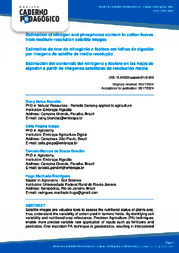Estimation of nitrogen and phosphorus content in cotton leaves from medium-resolution satellite images.
Estimation of nitrogen and phosphorus content in cotton leaves from medium-resolution satellite images.
Author(s): BRANDÃO, Z. N.; GREGO, C. R.; GONDIM, T. M. de S.; RODRIGUES, H. M.
Summary: Satellite images are valuable tools to assess the nutritional status of plants and, thus, understand the variability of cotton yield in farmers' fields. By identifying soil variability and nutritional crop reflectance, Precision Agriculture (PA) techniques enable more precise variable rate application of inputs such as fertilizers and pesticides. One important PA technique is geostatistics, resulting in interpolated maps that assist in evaluation during the crop cycle. These kriged maps provide a unique opportunity to overcome both spatial and temporal scaling challenges and understand the factors leading to crop yield. This study combines conventional statistical analysis, spatial regression modeling of georeferenced data, and vegetation indices assessment from medium-resolution satelitte images to support decisions on improving cotton yield. The experiments were conducted in a 44.8 ha commercial field in Goiás state, Brazil. Multispectral satellite images at 56 m spatial resolution were collected in a rainfed cotton field on 04/01/2011 and 04/10/2012 from the AWiF sensor during the peak flowering cotton stage. Measures of leaf nitrogen (N) and phosphorus (P) contents were determined over previously georeferenced central points of 70 plots of a regular grid, each one measuring 80X80 m. Using descriptive statistics and geostatistical analyses, data were analyzed by building and setting semivariograms and kriging interpolation. The best correlation was found between IVs and nitrogen contents of cotton leaves. Results indicated that NDVI, MSAVI, and SAVI were the best indices for estimating P contents at cotton peak flowering. Identifications of spatial differences were possible using geostatistical methods with remote sensing data obtained from medium-resolution satellite images, allowing the identification of distinct nutritional needs and growth status of canopy to cotton plants.
Publication year: 2024
Types of publication: Journal article
Unit: Embrapa Cotton
Keywords: Agricultura de Precisão, Algodão, Análise Geoestatística, Consumo de pesticida, Cotton, Dados georreferenciados, Farm inputs, Fertilizante, Fertilizers, Georeferenced data, Geostatistical analysis, Goiás, Imagem de satélite, Insumo, Krigagem, Kriging, Nutrição Vegetal, Pesticide application, Plant nutrition, Precision agriculture, Productivity, Produtividade, Remote sensing, Satellite image, Satélite, Sensoriamento Remoto, Spatial Variability, Variabilidade Espacial, Vegetation Indices, Índices de Vegetação
Observation
Some of Embrapa's publications are published as ePub files. To read them, use or download one of the following free software options to your computer or mobile device. Android: Google Play Books; IOS: iBooks; Windows and Linux: Calibre.
Access other publications
Access the Agricultural Research Database (BDPA) to consult Embrapa's full library collection and records.
Visit Embrapa Bookstore to purchase books and other publications sold by Embrapa.

